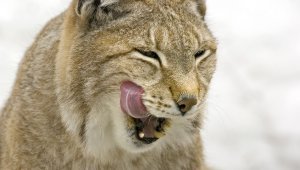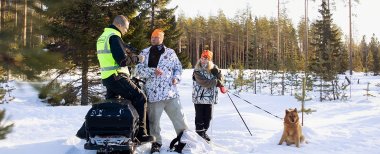Statistics show that in the first half of the 2000s, 20–40 dogs were lost to large carnivores each year. Roughly half of the incidents where wolves hurt or killed dogs happened in hunting situations and the other were incidents where a wolf snatched a dog from its home yard. The dogs lost in hunting incidents were mainly hounds and elkhounds whereas in the yard incidents the most common dog breed has been the Finnish Spitz. (Finnish Ministry of Agriculture and Forestry, 11/2005, Kojola & Kuittinen 2002). Kojola and Kuittinen (2002) have proposed the barking behaviours of the breeds as a possible explanation for this. The Spitz defends and guards its own yard loudly while hounds and elkhounds bark more than other dogs in a hunting situation. Wolves can hear a barking dog from a long distance.
According to Kojola and Kuittinen (2002), 65 wolf attacks on dogs were reported between 1996 and 1999. In 22 of these incidents the dog's owner reported the dog missing but no actual evidence of a wolf attack was found. In 82% of the confirmed cases the wolves killed the dog and usually also ate it. There are two hypotheses for why wolves kill dogs. According to the first the wolves are defending their territory and eliminating rivals, and the second points the finger at nutrition: the wolves are simply hungry. The latter is the more likely explanation in the case of lone wolves that live outside of packs and the former is more probable for wolf packs defending their territory. Incidents where a dog is taken from its own yard are typically the work of a lone wolf while hunting dogs are often attacked by two or more wolves (Kojola & Kuittinen 2002).
In studies conducted in Sweden (Backeryd 2007), a vast majority (86%) of wolf attacks on dogs happened in hunting situations and in 71% of those cases the attacked dog was killed. The dog was also eaten either partially or completely in 72% of these fatal cases. Hounds were over-represented among the killed hunting dog breeds in Sweden as well.
Large carnivore attacks on dogs are a very emotional issue as dogs are usually very important to their owners. The dog is not only a valuable and honoured hunting companion, but also a close friend to many people. If the dog killed by a large carnivore was not separately insured, the owner may seek compensation from the state. The dog's insured value is determined by its acquisition price as a puppy and factors that might add to the value, such as training, different character and health tests and dog show results. When determining the value of a dog, the owner should seek the counsel of the Finnish Kennel Club and the relevant breed associations.
Citations:
Backeryd 2007: Wolf attacks on dogs in Scandinavia 1995-2005. –Examensarbete, SLU, Uppsala 2007.
Kojola & Kuittinen 2002: Wolf attacks on dogs in Finland. –Wildl. Soc. Bull. 30(2): 498-501.
Finnish Ministry of Agriculture and Forestry 2005: Suomen susikannan hoitosuunnitelma (Finnish wolf population management plan). FMAF 11/2005.

